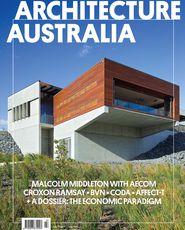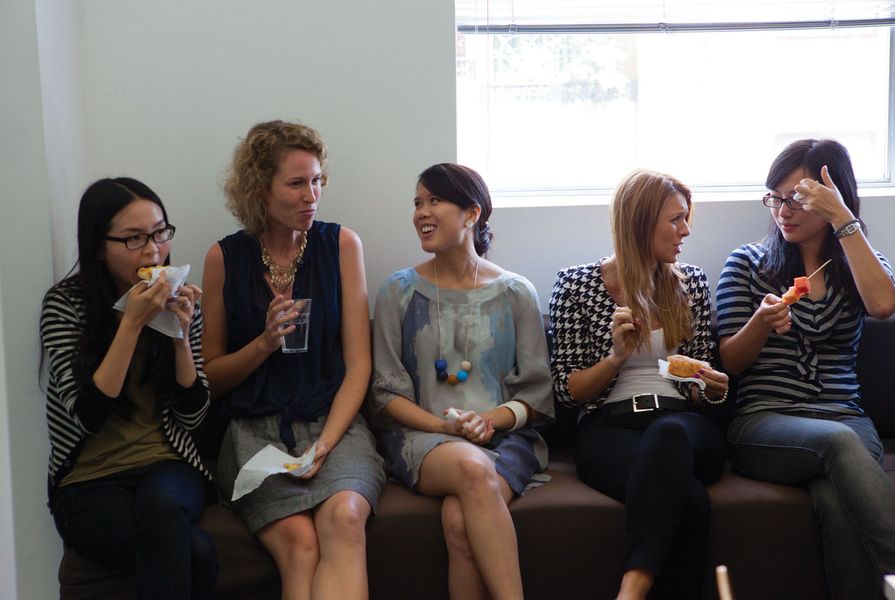Statistics about the participation of women in architecture carry grim economic news, both for the profession and for the women who are part of it. These statistics, which point to the economic disadvantage of women as a group in architecture, provide a compelling social justice case for change. But there are also economic arguments for improving the situation of women in architecture. The “business case” for gender equity demonstrates that practices can improve their performance by becoming more inclusive workplaces, and points out the costs to the profession of losing a significant number of highly educated architects. But this comes with warnings attached – it is not enough simply to employ more women. The business case cannot be disentangled from ethical and social justice issues – significant cultural change is needed if economic benefits are to flow.
In 2010, women architecture graduates started on salaries that were, on average, 88% of men’s starting salaries. Pictured here are some of the staff at Bates Smart.
Image: Nick Bassett
First, here are the alarming statistics. The most shocking data is contained in the 2010 Graduate Salaries Report. This reveals that women architecture and building graduates started on salaries that were, on average, 88% of men’s starting salaries. That is, a typical young woman started out in architecture in 2010 on $5,000 a year less than her male counterpart. This gap in median graduate starting salaries is larger than in any other industry surveyed (only four industries showed a statistically significant difference).1
The briefer data contained in the 2011 Grad Stats report indicates that last year the gender pay gap in architecture and building increased by another $2,000 (earth sciences had an even bigger gap). Why is the discrepancy in architecture and building larger than in most other industries? We don’t know. Anecdotally, we do know that women as a group do very well in architecture school, so it’s not a matter of skill difference.
Those surveyed are the “traditional” cohort – under twenty-five and in their first full-time job. So these statistics reflect the situation before the standard impediments to career progression, and concomitant effects on salary, kick in for most women (such as taking time off to care for children or other family members, not being promoted to leadership positions or not seeking such promotions).
The easy response to such pay gap data is that “women don’t ask.” This is partly true, but recent research also suggests that when women do ask they run the risk of being penalized, of being dismissed as “too aggressive.”2 This is a cultural issue, and we all need to start consciously addressing it.
There is no data on gender pay gaps later in architectural careers, but the anecdotal evidence is not good. For example, 48% of respondents to the recent UK survey by The Architects’ Journal felt they would be paid more if they were male. Here in Australia, the general statistics on pay gaps are also sobering. The Equal Opportunity for Women in the Workplace Agency reports that the gender pay gap in construction for 2011 was 16.8% and that the overall gap in mean weekly earnings for full-time employees increases with age. Combined with that starting salary gap for architectural graduates, things don’t look good.3 Indeed, it seems the question is not “Why do women leave architecture?” but rather, “Why do so many stay?”
Of the 10,385 members of the Australian Institute of Architects, 2,301 (22%) are women.
Image: Nick Bassett
Presently there are only basic measures of women’s participation in architecture. The most current statistical analysis comes from Gill Matthewson’s PhD research, underway at the University of Queensland:
- Of the 10,385 members of the Australian Institute of Architects, 2,301 are women (22%).
- Of the 11,090 registered architects in Australia, 2,290 are women (20.6%). This is despite women graduating in almost equal numbers for the last three decades.
Each of these statistics includes multiple complexities and we know that many women actively involved in architecture don’t show up in such metrics. But these metrics also reflect the traditional means for measuring participation and for gaining recognition within the profession.
So, there is a clear ethical argument for addressing the economic disadvantage of women in architecture (not to mention the legal obligation regarding pay equity, breaches of which can incur significant penalties). But we should also consider what it means for the profession to lose such a large proportion of its talent pool. This attrition of highly educated and skilled architects who happen to be women diminishes architecture’s potential for change and renewal. If the profession is to adapt effectively to new environments we need more people who think in diverse ways, not fewer. As Sarah Wigglesworth writes, “As people who tend to have portfolio careers, juggle competing needs, diversify their experience and make do financially, women are well placed to invent … new forms of practice.” But, she warns, “Time is critical, for if we don’t do it soon, we may have no profession at all.”4
The Australian profession needs to act collectively on this. The research project Equity and Diversity in the Australian Architecture Profession: Women, Work, and Leadership is developing a policy for the Australian Institute of Architects to help the profession address this inequity and to enable more women to participate fully. The first step is a Statement of Principle on Gender Equity. It is heartening that the Institute’s National Council is clearly committed to change, but policy can’t be effective in a vacuum. Change needs to come from all directions.
Individual practices, and leaders within them, must play a part, and this can be to their economic advantage. Business-case research does not focus on architecture, but the general findings are relevant. For example, diverse voices lead to more creative problem solving and better overall decisions, and therefore better economic performance – obvious assets in architectural practice.5 And if leadership and oversight from a diverse group improves corporate board outcomes it is likely to be effective for practice directors.
In terms of human resources, there are financial advantages in retaining staff, including a return on investment in training and development costs. Overall, workplaces with well-managed, inclusive and flexible cultures, able to attract and keep talented staff in difficult environments, show significant increases in productivity and in staff commitment and loyalty.
Architects have diverse clients and design for even more diverse building users. The profession should reflect this as a matter of professional responsiveness and responsibility. Practices that do are at an increasing advantage in terms of both better client service/communication and a broader base of experience from which to design and deliver projects. So the benefits include better buildings as well as better economic performance.
There is also the question of “brand” – of being seen to be enlightened, forward-thinking and innovative. This is double-edged; businesses that pursue diversity only for the “look” don’t reap the rewards. But those who make it work on multiple fronts also benefit from positive external perceptions. Genuine diversity and gender equity is a sign of a healthy organization, not merely an end in itself. And equity is not just a luxury for good economic times. As business organization Chief Executive Women points out, high-quality decision-making and retaining the best staff are even more important in tough economic environments.6
Through small and large actions every day we can address gender inequity in architectural workplaces.
Image: Nick Bassett
For diversity initiatives to have real economic impact the workplace must be genuinely inclusive, diversity must be actively managed, and those at the top must lead visibly. The authors of “Only Skin Deep? Re-Examining the Business Case for Diversity” point out that “diversity means more than having a sprinkle of women and a dab of colour … the value of diversity lies in developing an inclusive workplace – and that means adaptation, not just assimilation and tolerance.”7 They continue:
The story is not about the increased representation of a particular demographic group bringing extra ‘sparkle’ to the workplace because of their special skills and talents. Rather the story is about organizations with a more diverse talent pool, especially at senior levels, manifesting a workplace culture of openness, merit and rational decision-making. At heart, the story is one of diversity and inclusion of all employees, so that a richer knowledge bank is fully leveraged and better business outcomes are achieved.
To be effective, equity initiatives need to engage with the cultural contexts of specific workplaces. Unlike most “business case” case studies, many architectural practices are small. This does not mean the advantages don’t apply, but it does mean carefully analysing how particular practice structures interact with equity issues. And, given the limited material on developing equitable workplaces within small companies, architecture is in a position to show leadership and innovation.
But the question of culture also brings us slap up against the broader and more problematic aspects of some architectural workplaces – long hours (and their glorification), unpaid overtime, unrealistic deadlines, low pay, presenteeism, lack of flexibility, low fees and undercharging and sometimes just plain bad management. There is no evidence that these entrenched habits result in better architecture, or that they are in any way efficient. Indeed, such workplace culture is also one of the things that drives women out of architecture.8
One could argue, as Sarah Wigglesworth does in The Architect’s Journal, that many of architecture’s business practices are so problematic that moves to improve things for women could also result in a more viable future for the profession. She writes:
As the large construction companies increasingly call the shots and architects are relegated to the role of expendable aesthetes, the search for a reinvigorated practice that incorporates women’s unique contribution to a realignment of the discipline is especially important. One possible solution could be to fight to raise salary levels – which ultimately means fees. This might sound perverse, attacking the problem from the wrong end, but hear me out. Raising fee levels is a signifier of the value we place on ourselves and bring to others.
Through small and large actions every day we can address gender inequity in architectural workplaces.
Image: Nick Bassett
To deserve higher fees means demonstrating clearly why architecture is worth it: and this means becoming political. Higher fees would not only help improve architecture’s status, but crucially, provide choice. For women practitioners in particular, this would allow them to play a full part in shaping the future profession in new ways.
The good news is that there is a lot of very fine material out there for those who do want to make a difference – research, toolkits, assessment matrices, action plans, guidelines and specialist consultants all provide valuable knowledge and experience.
We all share the responsibility, and the opportunity, to address gender inequity in architectural workplaces through small and large actions every day. And who knows, architecture might be the better for it.
From a dossier in the May/June 2012 edition of Architecture Australia, on “The Economic Paradigm”.
1 Graduate Careers Australia, “Graduate Salaries” report, 2010. Architecture and building also had the second-largest difference in average working hours, with men working 3.1 more hours a week than women. This may account for some of the pay difference, although in architecture hours paid for don’t always reflect hours worked.
2 See Nancy M. Carter and Christine Silva, “The Myth of the Ideal Worker: Does Doing All the Right Things Really Get Women Ahead?” Catalyst, October 2011, (downloadable PDF from catalyst.org); Hannah Riley Bowles, Linda Babcock and Lei Lai, “Social Incentives for Gender Differences in the Propensity to Initiate Negotiations: Sometimes it Does Hurt to Ask,” Organizational Behavior and Human Decision Processes 103, 2007, 84–103; Jennifer Ludden, “Ask For A Raise? Most Women Hesitate,” NPR website, 14 February 2011, npr.org (accessed 3 May 2012).
3 Gender pay gaps and interrupted “non-traditional” career paths also lead to large gender gaps in superannuation savings. Economic disadvantage accumulates over time.
4 Sarah Wigglesworth, “Higher Fees Would Not Only Improve Architecture’s Status, But Give Women Freedom,” The Architects’ Journal, 19 January 2012, architectsjournal.co.uk/news/opinion/higher-fees-would-not-only-improve-architectures-status-but-crucially-give-women-freedom/8625212.article (accessed 3 May 2012).
5 Sujin Horwitz and Irwin Horwitz, quoted in “Only Skin Deep? Re-examining the Business Case for Diversity,” Deloitte Point of View, Human Capital Australia, September 2011.
6 “The Business Case for Women as Leaders: One Woman is not Enough,” Chief Executive Women website, 2009, cew.org.au. Refers to financial services firm Watson Wyatt Worldwide’s response to the turbulent economy in November 2008.
7 “Only Skin Deep?”, Human Capital Australia, September 2011, op. cit.
8 Ann de Graft-Johnson, Sandra Manley and Clara Greed, “Why do women leave architecture?” University of the West of England, Bristol, May 2003, architecture.com/Files/RIBAProfessionalServices/Education/DiscussionPapers/WhyDoWomenLeaveArchitecture.pdf (accessed 3 May 2012).
Source

Discussion
Published online: 24 May 2012
Words:
Justine Clark
Images:
Nick Bassett
Issue
Architecture Australia, May 2012























